A Design in Search of a Theory: A Case of Theoretical Modeling in Army Design Methodology
Richard A. McConnell, Edward N. Edens, Angela J. Allen, Joseph M. Ladymon, and Annie L. Robinson
Army Design Methodology (ADM) currently practiced by military professional planners applies a prescribed theoretical model in which to view the operational environment known as the operational variables. The operational variables consist of political, military, economic, social, information, infrastructure, physical environment, and time (PMESII-PT)[i]. While PMESII-PT is a useful theoretical model for analyzing the operational environment, it may not always be the best model to use in every situation. In some cases, classic theoretical modeling commonly used in scholarly research studies may prove more useful to military planners. Specifically, stability operations, which often prove challenging for developing distinguishable courses of action, scholarly theoretical modeling may provide triangulation through diverse perspectives (See figure 1). What follows is a brief literature review and a description of three cases of ADM planners at the U.S. Army Command and General Staff College (CGSC) substituting alternative theoretical models to that of PMESII-PT in the process of the Army Design Methodology. Using three distinctly different theoretical models, planners were able to develop three distinctly different operational approaches for application to the unique challenges existing in the operational environment in Columbia.
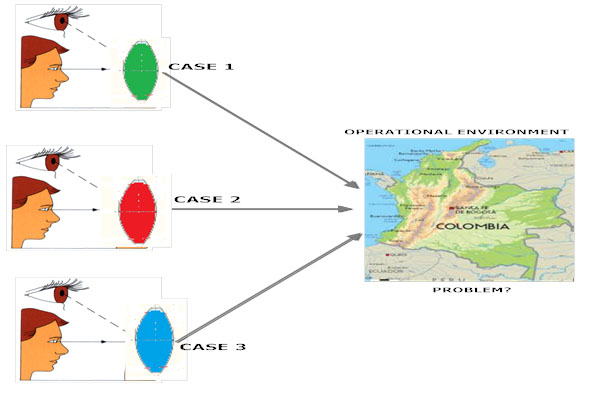
Figure 1: Theoretical Triangulation.
Literature Review
Army leaders rely on Army Design Methodology, which is useful for solving complicated, yet familiar problems. However, over the past decade, Army leaders and planners have struggled with several complex and unfamiliar problems such as the recent campaigns in Iraq and Afghanistan. In order to be successful in such an ambiguous strategic operational environment, military leaders are required to understand the environment through critical and creative thinking.
Graves and Stanley[ii] identify the importance of Army leaders focusing on critical and creative thinking when it comes to developing and solving strategic and operational problems. They examined the recent history of how Army planners have attempted to think “outside of the box” by examining the concept of Army Design doctrine which began in 2009 with the Army Field Manual-Interim (FMI) which applied critical thinking to planning. Additionally, the Operations process developed in 2010, focused on greater flexibility, critical thinking, and initiative. Most recently, in 2012 Army Design Methodology Commander’s Resource[iii] was developed to incorporate design theory and with the design methodology to make the ADM process more accessible to all.
Bullock, Xander, and Vitor[iv] stated that since design is part of Army Doctrine, the argument is no longer “should” we use design but how it can best be incorporated to allow leaders to achieve the best outcomes to the current operational environments. The authors maintained that in order to incorporate design effectively; there must be a cultural shift toward a corporate leader paradigm where the commander remains central to the planning. Under such an approach to design, no longer would a single PowerPoint brief or a narrative prove sufficient for accurately describing problems in operational environments. Communication between planners and commanders should be a continuous process, where understanding and discourse flow freely. Although communication is of paramount importance, obstacles to the use of design during conceptual planning persist.
Zweibelson[v] explored the challenges of integrating design theory into the military’s planning process and the reasons he believes the United States military will not completely adopt design theory concept in its planning process. He asserted the reason some planers avoid design theory is because it forces military planners to look at problems from an unfamiliar perspective. This perspective might not provide the amount of certainty that the current planning models did and with which many planners were accustomed. Zweibelson argued that the current system logic was composed of reductionism, mechanistic processes, and linear causality, which may not work in the complexity of this century. Although such logic may have worked in the past and may work for some of the current problems, it is highly unlikely they will work for every problem, which may require intellectual flexibility such as the ability to improvise.
Weick[vi] argued that improvisation could help organizations succeed and achieve greater goals because the overall thinking and strategies were not rooted in past behaviors or actions. Not every organization could benefit from improvisation; however, some might benefit greatly from this approach. The author used the basic tenets of jazz improvisation as an approach organizations could use to better develop techniques and strategies when dealing with the unknown. An important factor for improvisation to be successful would be for an organization to improve its organizational memory as well. This would allow for the development of a stockpile of resources one could retrospectively access allowing creative and critical thinking to occur, which would allow for more improvisational thinking overall. Such improvisational thinking could greatly improve the cognitive foundation for Army Design efforts.
Army Design Methodology (ADM)
Zweibelson[vii] argued that the conceptual approach of design and the detailed planning of the military decision-making process make for awkward dance partners because of ontological, epistemological, and methodological differences. This author provided descriptions from existing literature of these ontological, epistemological, and methodological differences in a series of quad charts depicting tacit versus explicit knowledge on one continuum in competition with technical rationalism versus reflective constructionist perspectives on another continuum. Zweibelson asserted that military professionals attempt to force design into a more detailed planning paradigm rather than accepting the tacit reflective perspective offered by design. Oversimplifying design theory in order to force this tacit reflective perspective into the military cultural predilection for explicit approaches such as the military decision-making process oversimplifies design degrading its use. This author’s literature review is pertinent to the discussion of theoretical triangulation because it contains descriptions of how design uses theoretical modeling to inform its ontological and epistemological perspective. Planners at CGSC were seeking alternative theoretical models for use during conceptual planning and selected Force Field Analysis (see figure 2) as the foundational theory upon which to build unique approaches to obtain theoretical triangulation[viii].
Force Field Analysis
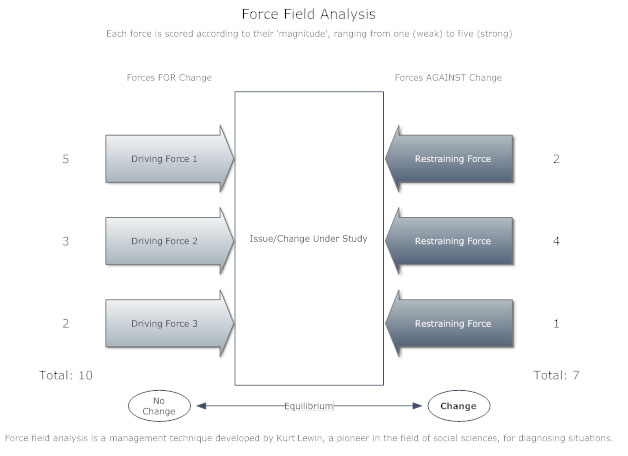
Figure 2: Modified Force Field Analysis.
The figure is a display of Force Field Analysis theoretical model [ix].
Scholarly Design Applications
Case One: Hawkeye Theoretical Model
In Case one, the theoretical model to address the situation in Colombia combined elements from Force Field Analysis and Health Belief Model (HBM) (see figure 3)[x]. The HBM is a psychological health behavior change model developed to explain and predict health-related behaviors. The model suggests people’s beliefs about health issues, perceived benefits of action and barriers to action, as well as their self-efficacy, explain engagement as well as lack of it in health-promoting behavior.
The notions of modifying factors and individual perceptions from the HBM were incorporated into Force Field Analysis, which was then applied to competing forces in Columbian society. These two categories were divided into positive and negative groups, based on how they affect the people of Colombia identified as the center of gravity. Utilizing the Clausewitzian concept of the center of gravity (CoG), defined as, “the source of power that provides moral or physical strength, freedom of action, or will to act,” [xi] planners identified the people of Colombia as the CoG. Ultimately, the people would determine the fate of the country by either accepting or rejecting the controls and measures that the government desired to enact, and accepting or rejecting the influence of nefarious non-state entities.
The resultant model was constructed as a two-dimensional version of the Force Field Model, with positive/negative perceptions exerting influence on the people that varies along the x-axis, and positive/negative factors exerting influence on the people that varies along the y-axis. This theoretical model resembled an arrow and thus was named for the Marvel comic character Hawkeye[xii].
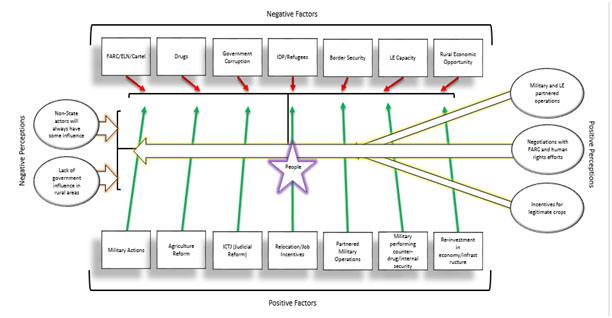
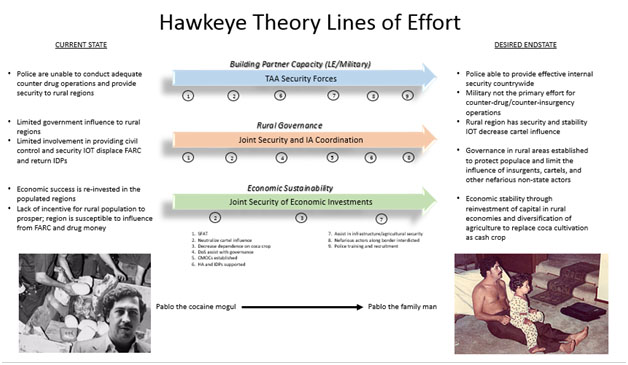
Figure 3: Hawkeye Theoretical Model to Stability Operations in Columbia.
The figure depicts the Hawkeye theoretical model combined with Force Field Analysis and the lines of effort resulting from this theoretical approach.
(Images of Pablo Escobar accessed from nolovasaleer.com & rudebutgood.blogspot.com)
Case Two: Rolling Stone Theoretical Model for Stability Operations in Columbia
Stability planners used a hybrid theoretical model that combined Stakeholder Analysis with Force Field Analysis (see figure 4)[xiii]. The Stakeholder Analysis systematically identifies qualitative information about individuals and groups that are likely to affect or be affected by a proposed action. This combination of theories into a model assisted in assessing how the interests of the stakeholders should be addressed in planning, policy, and programs.
By applying Stakeholder Analysis to Force Field analysis, planners were able to diagram the needs of the various stakeholders in Colombia focusing on the threat organizations (FARC and ELN) and the Colombian Government. The circles represent environmental conditions, which benefit stakeholders. On the threat group portion of the diagram the drug demand, drug supply, and instability benefit the FARC and ELN. The overlapping portions of the circles represent forces that strengthen the organization because of the overlapping environmental conditions. On the threat group side are revenue (generated at the intersection of drug supply and drug demand), freedom of movement (at the intersection of drug demand and instability), and a labor force (at the intersection of Instability and drug supply).
On the Colombian Government portion of the diagram, stability was a required condition of the environment to support trade leading to increased foreign investment, foreign relations, and legitimacy. The model illustrated the source of conflict between the stakeholders as they shared a common thread in the area of stability with threat forces thriving on instability and the Colombian government requiring stability. These two competing VIN diagrams (or stones) have the ability to respond to forces that may cause them to roll towards or away from stability outcomes embodied by the rolling stone title of this theoretical model.
Planners used Force Field Analysis to generate Lines of Effort (LOE). The Lines of Effort represented forces rolling the instability stone from the threat group side to the government side. The effect on the threat group was decreased freedom of movement and a decreasing available labor force as economic stability and security are increased effectively giving the population a viable alternative to working for the cartels without fear of retaliation. The drug demand was external to the system and outside the purview of what a deployed unit could effect. This circle could be addressed using a whole of government approach to reduce the demand signal coming from the United States. An improved security environment could influence the drug supply stone indirectly. Such an improved security environment could make it more difficult for the threat groups to acquire and hold land, labor, transportation, storage, and processing facilities.
The Rolling Stone Theoretical Model allowed planners to visualize the common threads between the groups and recognize opportunities to change the environment to favor the government through security cooperation. Planners could also visualize the effects on each stakeholder when a circle was pulled away as the overlapping portions were squeezed and ultimately eliminated. A reduction in instability on the threat group side reduced the labor force and freedom of maneuver for the cartels, while simultaneously increasing the favorable condition of stability on the government side, setting the conditions for increased security cooperation and foreign investment. The stability circle represented a cornerstone on the government side supporting both trade and legitimacy.
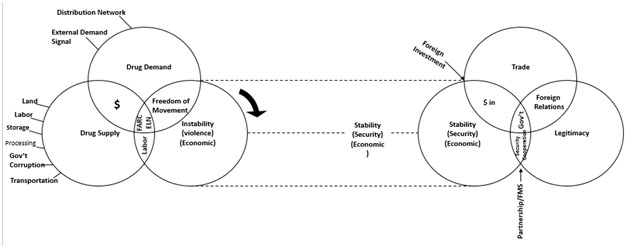
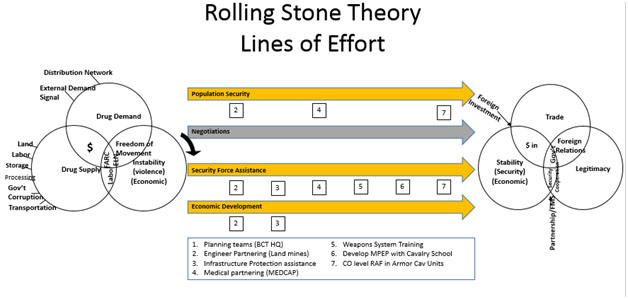
Figure 4: The Rolling Stone Theoretical Model to Stability Operations in Columbia.
This figure depicts the Rolling Stone Theory combined with Force Field Analysis and the lines of effort resulting from this theoretical approach.
Case Three: System of Force Fields Theoretical Model for Stability Operations in Columbia
System of Systems Analysis was useful for visualizing a collection of task-oriented systems where resources and capabilities were brought together to create a new system which offered more functionality and performance than any single stand-alone system[xiv].
Using a System of Systems Analysis approach, planners were able to accurately define the Operational Environment. This was then combined with a modified version of the Force Field Analysis theoretical model to determine what the resistors and drivers for change were in Colombia and how those forces affected the System of Systems. This combination of theoretical models became the System of Force Fields theoretical model (see figure 5).
The center of gravity (COG) was identified using the System of Force Fields theoretical model. This COG and the desired end states were used to develop the line of efforts used to achieve the desired effects.
The use of the combination of System of Systems Analysis and Force Field Analysis allowed planners to digest copious amounts of information in a rapid fashion and allowed for nodes and links to be quickly identified. Using this theoretical model permitted the group to focus and gain more clarity in its thinking. Additionally, this clarity of thinking allowed for the group to identify the required lines of effort to achieve the desired end states faster by seeing the interrelated links and nodes and the key resistors to change. By addressing these key resistors, the group was able to develop a synchronized and synergistic operational approach.
The System of Force Fields theoretical model was different from the PMESII-PT model used in ADM because it illustrated the drivers and resistors interactions with systems more clearly than a standard PMESII-PT model. The System of Force Fields theoretical model permitted planners to identify the resistors to change and develop the needed lines of effort to make those changes a reality. Ultimately, the System of Force Fields theoretical model provided a more comprehensive and readily identifiable links and nodes than the standard PMESII-PT model might have been able to facilitate during the ADM process.
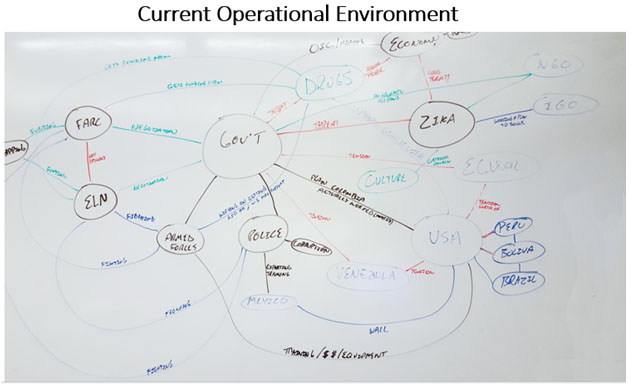
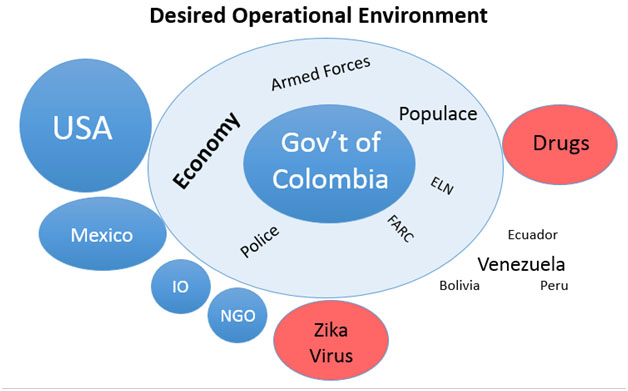
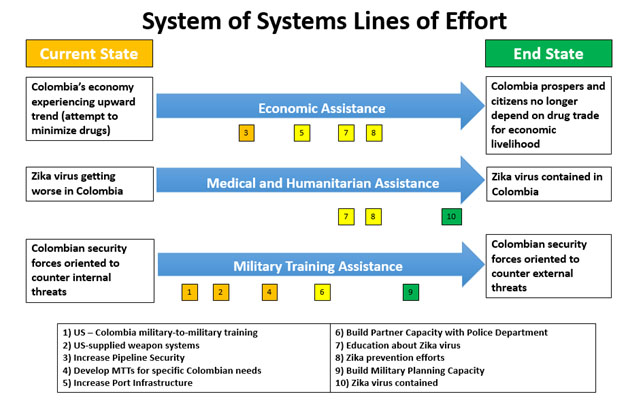
Figure 5: The System of Systems Theoretical Model to Stability Operations in Columbia.
This figure depicts the System of Systems Theory combined with Force Field Analysis and the lines of effort resulting from this theoretical approach.
Findings
Cases one through three demonstrated the utility of adapting diverse theoretical models during the Army Design Methodology process in order to achieve theoretical triangulation. When utilizing PMESII-PT as the primary theoretical model for concurrent planning efforts, it should not be surprising that developing distinguishable operational approaches might prove challenging. However, by starting from diverse theoretical perspectives, planners in all three cases were able to produce distinguishable operational approaches because they viewed the problem through divergent theoretical lenses. Figures 3 through 5 depict distinctly different theoretical perspectives, which enabled the planners to create operational approaches unique from each other facilitating a deeper understating of the problem prior to seeking to develop solutions. These three conceptual planning groups provided the commander with an increased breadth and depth of understanding the operational environment.
Recommendations
Planners seeking to encourage distinctly distinguishable operational approaches to a problem should consider starting from divergent theoretical perspectives. By beginning from divergent theoretical perspectives, the planners in these cases were able to obtain deeper understanding of the operational environment enabling them to produce divergent approaches to the problem rather than three re-interpretations of PMESII-PT.
Conclusion
Problem identification is one of the most crucial things military professional planners do during conceptual planning before they move to detailed planning. Unfortunately, if military planners always use the same theoretical model to analyze the environment, the possible result could be formulaic and paradigmatic thinking. By introducing alternative theories and theoretical modeling, military planners may be able to achieve triangulation using multiple theoretical perspectives of the same environment. By substituting alternative theoretical models to that of PMESII-PT, the three described cases in this article were able to obtain three distinct perspectives on the same operational environment producing distinctively different operational approaches. By incorporating varied theoretical modeling into Army Design Methodology, commanders may be able to achieve dynamic perspectives that may be more comprehensive than previously made possible by using PMESII-PT.
References
Bar-Yam, Yaneer, Mary Ann Allison, Ron Batdorf, Hao Chen, Hoa Generazio, Harcharanjit Singh, and Steve Tucker. “The Characteristics and Emerging Behaviors of System of Systems.” NECSI: Complex Physical, Biological and Social Systems Project, January 7, 2004, 1–16.
Brown, D. R. An Experiential Approach to Organization Development. Upper Saddle River, N.J.: Prentice Hall, 2011.
Bullock, Xander, and Bruce Vitor. “Design: How, Not Why.” Military Review 90, no. 2 (March 1, 2010): 102.
Department of the Army. ATP 5-0.1 Army Design Methodology. Washington, D.C.: U.S. Government Printing Office, 2015.
———. JP 1-02 Department of Defense Dictionary of Military and Associated Terms. Washington D.C.: U.S. Government Printing Office, 2016. http://www.dtic.mil/doctrine/new_pubs/jp1_02.pdf.
Fraction, Matt. Hawkeye, Vol. 1: My Life as a Weapon. New York: Marvel, 2013.
Graves, Thomas, and Bruce E. Stanley. “Design and Operational Art: A Practical Approach to Teaching the Army Design Methodology.” Military Review 93, no. 4 (2013): 53.
Grome, Anna, Beth Crandal, Louise Rasmussen, and Heather Wolters. “Army Design Methodology Commander’s Resource.” Research Product. Arlington, VA: Army Research Institute, February 2012.
Janz, Nancy K., and Marshall H. Becker. “The Health Belief Model: A Decade Later.” Health Education & Behavior 11, no. 1 (March 1, 1984): 1–47. doi:10.1177/109019818401100101.
Lewin, K. “Defining the ‘Field at a given Time.’” Psychological Review 50, no. 3 (1943): 292–310. doi:10.1037/h0062738.
Schmeer, Kammi. “Guidelines for Conducting Stakeholder Analysis.” In Health Reform Tools Series. Bethesda, MD: Partnerships for healthcare reform, Abt Associates Inc., 1999.
Weick, Karl E. “Introductory essay—Improvisation as a Mindset for Organizational Analysis.” Organization Science 9, no. 5 (1998): 543–555.
Zweibelson, Ben. “An Awkward Tango: Pairing Traditional Military Planning to Design and Why It Currently Fails to Work.” Journal of Military and Strategic Studies 16, no. 1 (March 18, 2015). http://jmss.org/jmss/index.php/jmss/article/view/587.
———. “Design Theory and the Military’s Understanding of Our Complex World.” Small Wars Jounal, August 7, 2011.
End Notes
[i] Department of the Army, ATP 5-0.1 Army Design Methodology (Washington, D.C.: U.S. Government Printing Office, 2015).
[ii] Thomas Graves and Bruce E. Stanley, “Design and Operational Art: A Practical Approach to Teaching the Army Design Methodology,” Military Review 93, no. 4 (2013): 53.
[iii] Anna Grome et al., “Army Design Methodology Commander’s Resource,” Research Product (Arlington, VA: Army Research Institute, February 2012).
[iv] Xander Bullock and Bruce Vitor, “Design: How, Not Why,” Military Review 90, no. 2 (March 1, 2010): 102.
[v] Ben Zweibelson, “Design Theory and the Military’s Understanding of Our Complex World,” Small Wars Jounal, August 7, 2011.
[vi] Karl E. Weick, “Introductory essay—Improvisation as a Mindset for Organizational Analysis,” Organization Science 9, no. 5 (1998): 543–555.
[vii] Ben Zweibelson, “An Awkward Tango: Pairing Traditional Military Planning to Design and Why It Currently Fails to Work,” Journal of Military and Strategic Studies 16, no. 1 (March 18, 2015), http://jmss.org/jmss/index.php/jmss/article/view/587.
[viii] K. Lewin, “Defining the ‘Field at a given Time.,’” Psychological Review 50, no. 3 (1943): 292–310, doi:10.1037/h0062738.
[ix] D. R. Brown, An Experiential Approach to Organization Development (Upper Saddle River, N.J.: Prentice Hall, 2011).
[x] Nancy K. Janz and Marshall H. Becker, “The Health Belief Model: A Decade Later,” Health Education & Behavior 11, no. 1 (March 1, 1984): 1–47, doi:10.1177/109019818401100101.
[xi] Department of the Army, JP 1-02 Department of Defense Dictionary of Military and Associated Terms (Washington D.C.: U.S. Government Printing Office, 2016), http://www.dtic.mil/doctrine/new_pubs/jp1_02.pdf.
[xii] Matt Fraction, Hawkeye, Vol. 1: My Life as a Weapon (New York: Marvel, 2013).
[xiii] Kammi Schmeer, “Guidelines for Conducting Stakeholder Analysis,” in Health Reform Tools Series (Bethesda, MD: Partnerships for healthcare reform, Abt Associates Inc., 1999).
[xiv] Yaneer Bar-Yam et al., “The Characteristics and Emerging Behaviors of System of Systems,” NECSI: Complex Physical, Biological and Social Systems Project, January 7, 2004, 1–16.
